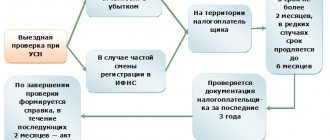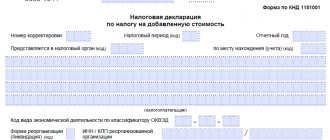Tax reporting: features of formation and submission to the Federal Tax Service
Main features that determine the reporting procedure
According to Article 313 of the Tax Code of the Russian Federation, the tax reporting regime is determined by each economic entity, based on a convenient tax policy, goals and specifics of conducting economic activity. However, this does not mean that every organization can report to the Federal Tax Service in the way that is convenient for it. It is necessary to comply with certain requirements, namely to ensure that regulatory authorities are able to:
- chronological display of accounting information, continuous and complete;
- determination of all essential facts of economic activity of an economic entity;
- systematization and analysis of accounting data;
- adequate assessment of income and expenses of an economic entity;
- calculate the amount of income tax of a business entity.
The organization of the tax accounting system is initially independent, since it is not subject to the same strict rules and requirements as the accounting system. Thus, regulatory authorities do not require enterprises to submit tax reports according to any unified forms and standards.
Thus, legal entities and individual entrepreneurs can organize tax accounting in the following ways:
- Autonomous method of tax accounting.
This system has nothing to do with accounting. All significant business transactions are reflected in tax accounting registers.
- Formation of a tax accounting system based on accounting data.
For many enterprises, this method is more appropriate, since it fully complies with the requirements of Article 313 of the Tax Code of the Russian Federation, and also takes significantly less time from accountants.
Article 313 determines the taxable base precisely on the basis of tax accounting data. At the same time, Chapter 25 of the Tax Code clearly separates the concepts of accounting and tax accounting, defining for the latter a special procedure for systematizing data and business transactions.
If the rules for maintaining tax and accounting records within one business entity coincide, the taxable base is determined precisely on the basis of accounting data. In this case it is necessary:
- Clearly define the objects of tax accounting according to NU and BU data. Distinguish between objects for which the accounting rules for both systems differ.
- Determine the procedure for using information to calculate the taxable base from accounting data.
- Determine the forms of analytical registers for each of the tax accounting objects.
- Determine the objects of separate taxation when applying any special taxation systems.
If an accountant or other specialist of the organization was able to properly organize the tax accounting system, this will greatly simplify the process of generating and submitting tax reports to the Federal Tax Service.
LLC reporting in 2021
Home / Other
The reporting documentation, which is required to be submitted to the regulatory authorities of a legal entity, can be divided into 5 groups:
- Reporting according to the selected tax regime.
- Reporting for employees (mandatory, since in any organization there is at least one worker - a manager).
- Financial statements.
- Reporting on other taxes.
- Statistical reporting (to Rosstat).
Note: in addition to submitting reports, cash transactions are kept track of, and LLCs using the simplified tax system keep records of income/expenses in KUDiR.
If you don’t want to sort through a bunch of reporting and waste time going to the tax office, you can use this online service, which has a free trial period.
Reporting according to the applicable taxation system
It is submitted to the Federal Tax Service inspection at the place of registration of the legal entity (a separate division of the legal entity / at the place of actual conduct of UTII activities).
| Tax regime | Type of reporting documentation | Report submission deadlines |
| BASIC | VAT declaration | At the end of each quarter until the 25th day of the month (inclusive) following the reporting quarter |
| Income tax return | For the 1st quarter, half-year and 9 months up to the 28th day of the month (inclusive) following the reporting quarter For the year - up to and including March 28 of the next year | |
| Calculations for advance payments and property tax declaration | Calculations are submitted for the 1st quarter, half a year, 9 months up to the 30th day (inclusive) of the month following the reporting quarter Declaration - based on the results of the year until March 30 of the next year inclusive | |
| simplified tax system | Declaration of the simplified tax system | At the end of the year no later than March 31 of the following year |
| UTII | Declaration on UTII | At the end of the quarter no later than the 20th day of the month following the reporting quarter |
| Unified agricultural tax | Declaration on Unified Agricultural Tax | At the end of the year until March 31 of the next year inclusive |
| All special-regime organizations that carry out intermediary activities under agency agreements (commissions, orders) with counterparties on OSNO and receive/register tax invoices with VAT for this type of activity | Journal of received/issued invoices | At the end of the quarter no later than the 20th day of the month following the reporting quarter |
When combining different taxation systems, reporting should be submitted separately for each tax regime applied.
Reporting for employees
Reporting documentation for employees can be divided into 3 categories depending on the authority to which such reporting is submitted: the Federal Tax Service, the Social Insurance Fund and the Pension Fund.
| Type of reporting documentation | Supervisory authority | Submission deadlines |
| Information on the average number of personnel | Inspectorate of the Federal Tax Service | Based on the results of the calendar year, no later than January 20 of the year following the reporting year |
| Unified calculation of insurance premiums (ERSV) | At the end of the 1st quarter, half-year, 9 months and year, no later than the 30th day of the month following the reporting period (quarter) | |
| Form 6-NDFL | Similar to ERSV, with the exception of the annual report - for the year the form is submitted no later than April 1 of the next year | |
| Help 2-NDFL | At the end of the year no later than April 1 of the year following the reporting year | |
| Form SZV-M | Pension Fund | Monthly before the 15th day of the month following the reporting month |
| Forms: SZV-STAZH, EDV-1 | At the end of the year until March 1 of the year following the reporting year When an individual submits an application for retirement - within 3 days from the moment the person contacts the employer | |
| Calculation 4-FSS | FSS | Based on the results of the 1st quarter, half year, 9 months and year. Until the 20th day (inclusive) of the month following the billing period (when the form is submitted on paper), or until the 25th day of the month following the billing period (when submitted electronically) |
| Application and certificate confirming the main type of activity | Annually before April 15 of the year following the reporting period |
Financial statements
All companies are required to annually submit accounting reports to the Federal Tax Service at the place of registration, regardless of the tax regime used and the number of hired personnel.
Accounting reports are submitted at the end of the calendar year no later than March 31 of the year following the reporting year.
The number of forms submitted depends on the category of the organization.
Small enterprises (staff - up to 100 people, revenue up to 800 million rubles per year) rent out:
- balance sheet (form 1);
- statement of financial results (form 2).
Note: such reporting can be presented in both standard and simplified forms.
All other organizations (medium, large, largest taxpayers) additionally represent:
- statement of changes in capital (form 3);
- cash flow statement (form 4);
- report on the intended use of funds (form 6);
- explanations to the financial statements in text or tabular form.
Reporting on other types of taxes
Some enterprises, by type of activity, are subject to additional taxation and, accordingly, must report to the Federal Tax Service on the following taxes and fees:
| Tax/fee | Reporting type | Submission deadlines |
| Transport | Transport tax declaration | Based on the results of the year, no later than February 1 of the following year |
| Water | Water tax declaration | Based on the results of each quarter no later than the 20th day of the month following the billing quarter |
| Land | Land tax declaration | At the end of the year no later than February 1 of the following year |
| Excise | Excise tax declaration | Monthly until the 25th day of the next month (for straight-run gasoline and denatured alcohol: until the 25th day of the third month following the billing month) |
| Notice of advance payment and copies of payment documents | No later than the 18th of the current month | |
| For the gambling business | Gambling tax return | At the end of each month no later than the 20th day of the next month |
| For mining | Declaration on mineral extraction tax | Every month no later than the last day of the next month |
| Regular payments for subsoil use | Calculation of payments for subsoil use | Quarterly no later than the last day of the month following the billing quarter |
| Fee for the use of water resources | Information about issued permits and fees payable | Within 10 days from the date of issue of the permit |
| Information on the number of objects removed from the habitat | No later than the 20th day of the month following the last month of the permit validity period | |
| Fee for the use of wildlife objects | Information on issued permits for the extraction of animals | Within 10 days from the date of issue of the permit |
Statistical reporting
All companies are required to submit to Rosstat a copy of their annual financial statements (including a statement of financial results and other appendices, if any) no later than three months from the end of the reporting year.
Firms belonging to the category of small enterprises that came under selective observation, as well as companies belonging to the sector of medium, large and largest businesses, must submit statistical reporting in forms approved by Rosstat.
Statistical authorities are obliged to inform companies about the need to submit reports by sending out relevant notifications. You can check which statistical reports an organization must submit yourself on the website: statreg.gks.ru
If a company must report to Rosstat, the following information will be displayed on the website:
- a list of reports to be submitted;
- deadlines for their submission;
- instructions for filling out reporting documentation.
All small enterprises also submit reports to Rosstat as part of continuous monitoring, which is carried out once every 5 years. The next total audit will take place in 2021; accordingly, all small business representatives will have to report to the statistical authorities in 2021.
Read in more detail: All LLC reporting
Did you like the article? Share on social media networks:
- Related Posts
- Tax holidays for individual entrepreneurs in 2021
- Budget classification code (BCC): table
- Taxes and payments for individual entrepreneurs in 2021
- Personal income tax for employees (income tax)
- Insurance premiums for employees in 2021
- Personal income tax (NDFL)
- Liquidation of an LLC in 2021: step-by-step instructions
- Reporting for employees in 2021
Discussion: 4 comments
- Vasily Alekseev:
02/16/2018 at 09:30Helpful information. Thank you, but Rosstat employees need to familiarize themselves with it.
Answer
- Nikolay:
12/25/2019 at 06:12
What about Rosprirodnadzor reporting? To whom should I submit which reports and in what time frame?
Answer
- Nikolay:
02/06/2020 at 13:55
6-NDFL and 2-NDFL for 2021 must be submitted by March 2, 2021. And not until 04/01/20 as indicated in your article. Federal Law of September 29, 2019 N 325-FZ “On Amendments to Parts One and Two of the Tax Code of the Russian Federation”
Answer
- egrul:
06/02/2020 at 09:47
Yes, now it’s easy to submit reports using an electronic digital signature for reporting. Just be sure to specify this when ordering a signature! Because without a special certificate for the father. nothing will come of it. Costs 3500-5000 on average. There are even signatures with which you can report directly from 1C (and not necessarily licensed))). If anyone needs help, ask. I’ll be happy to help, there’s a nickname in the cart...
Answer




